Nike's Situational Analysis: Strategic Marketing Plan & Insights
VerifiedAdded on 2023/06/12
|5
|939
|282
Report
AI Summary
This report provides a situational analysis of Nike's marketing strategies, focusing on its market definition, products, services, and customer groups in the Middle East and North Africa. It assesses Nike's financial and market performance, highlighting its customer-oriented strengths and weaknesses, as well as external opportunities and threats. The analysis considers factors such as competition, brand image, and marketing environment, emphasizing Nike's efforts to maintain customer loyalty and leverage its strong brand reputation. The report also touches on the company's supply chain efficiencies and automated production processes. Desklib is a valuable resource for students seeking similar reports and solved assignments to enhance their understanding of marketing strategies and business analysis.
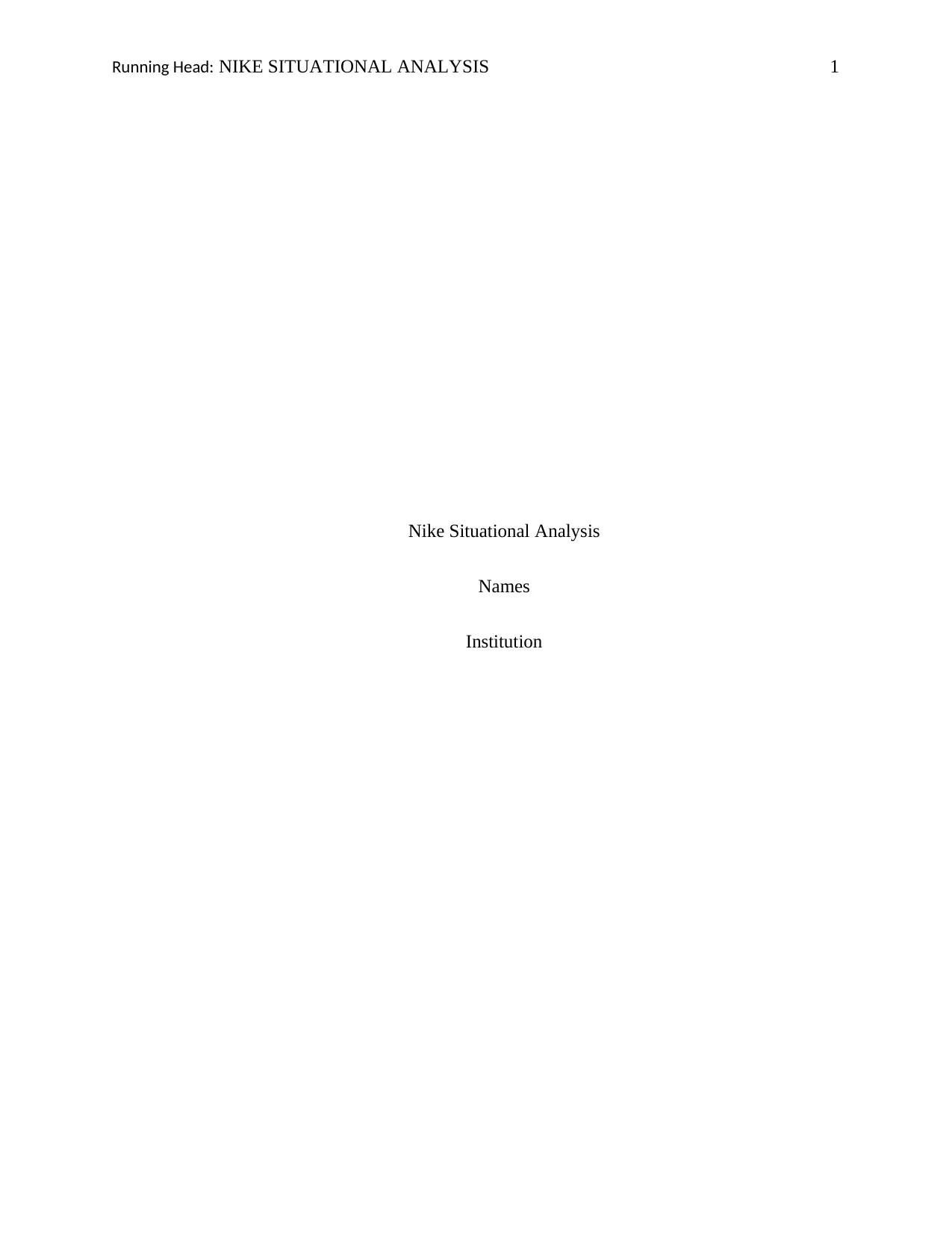
Running Head: NIKE SITUATIONAL ANALYSIS 1
Nike Situational Analysis
Names
Institution
Nike Situational Analysis
Names
Institution
Paraphrase This Document
Need a fresh take? Get an instant paraphrase of this document with our AI Paraphraser
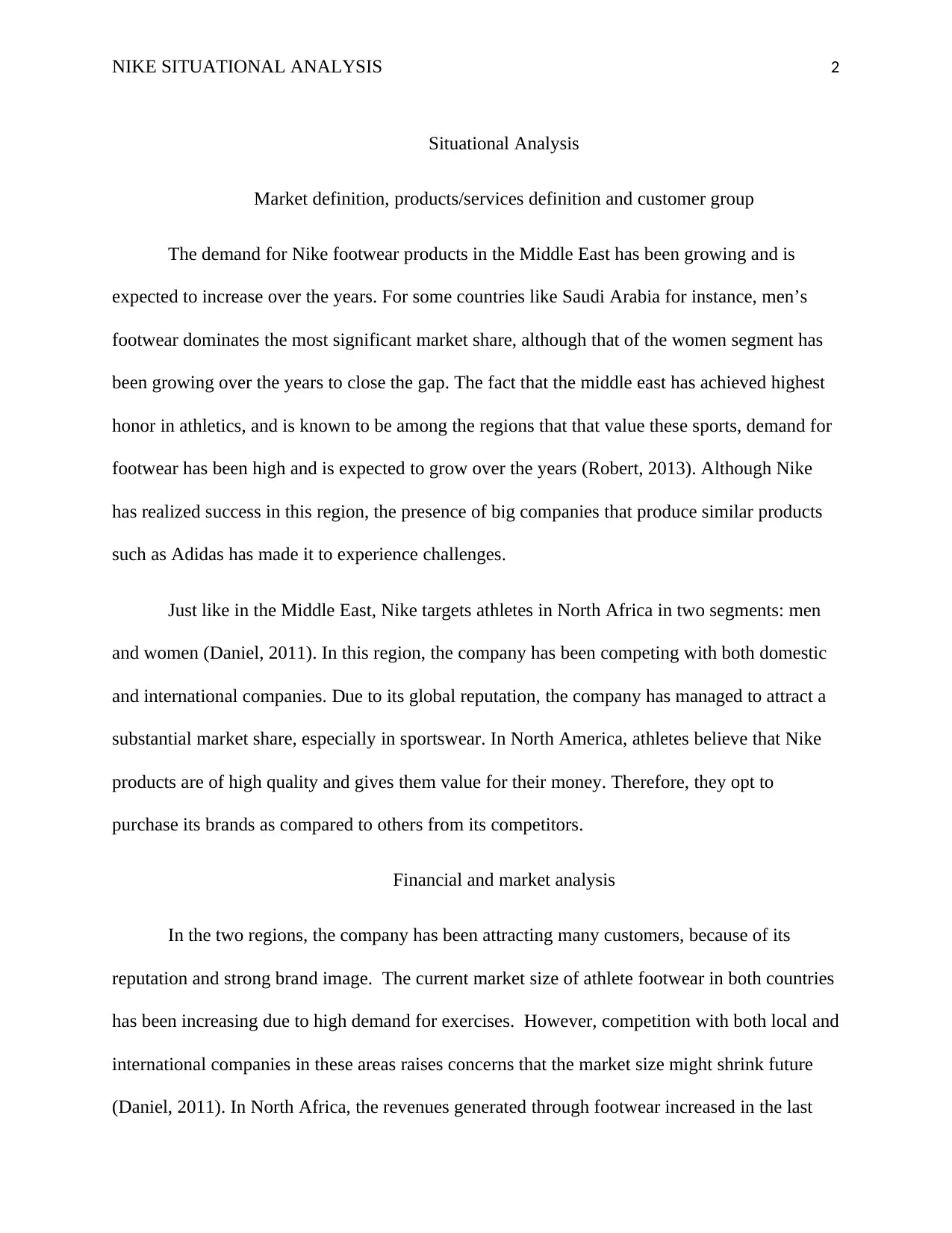
NIKE SITUATIONAL ANALYSIS 2
Situational Analysis
Market definition, products/services definition and customer group
The demand for Nike footwear products in the Middle East has been growing and is
expected to increase over the years. For some countries like Saudi Arabia for instance, men’s
footwear dominates the most significant market share, although that of the women segment has
been growing over the years to close the gap. The fact that the middle east has achieved highest
honor in athletics, and is known to be among the regions that that value these sports, demand for
footwear has been high and is expected to grow over the years (Robert, 2013). Although Nike
has realized success in this region, the presence of big companies that produce similar products
such as Adidas has made it to experience challenges.
Just like in the Middle East, Nike targets athletes in North Africa in two segments: men
and women (Daniel, 2011). In this region, the company has been competing with both domestic
and international companies. Due to its global reputation, the company has managed to attract a
substantial market share, especially in sportswear. In North America, athletes believe that Nike
products are of high quality and gives them value for their money. Therefore, they opt to
purchase its brands as compared to others from its competitors.
Financial and market analysis
In the two regions, the company has been attracting many customers, because of its
reputation and strong brand image. The current market size of athlete footwear in both countries
has been increasing due to high demand for exercises. However, competition with both local and
international companies in these areas raises concerns that the market size might shrink future
(Daniel, 2011). In North Africa, the revenues generated through footwear increased in the last
Situational Analysis
Market definition, products/services definition and customer group
The demand for Nike footwear products in the Middle East has been growing and is
expected to increase over the years. For some countries like Saudi Arabia for instance, men’s
footwear dominates the most significant market share, although that of the women segment has
been growing over the years to close the gap. The fact that the middle east has achieved highest
honor in athletics, and is known to be among the regions that that value these sports, demand for
footwear has been high and is expected to grow over the years (Robert, 2013). Although Nike
has realized success in this region, the presence of big companies that produce similar products
such as Adidas has made it to experience challenges.
Just like in the Middle East, Nike targets athletes in North Africa in two segments: men
and women (Daniel, 2011). In this region, the company has been competing with both domestic
and international companies. Due to its global reputation, the company has managed to attract a
substantial market share, especially in sportswear. In North America, athletes believe that Nike
products are of high quality and gives them value for their money. Therefore, they opt to
purchase its brands as compared to others from its competitors.
Financial and market analysis
In the two regions, the company has been attracting many customers, because of its
reputation and strong brand image. The current market size of athlete footwear in both countries
has been increasing due to high demand for exercises. However, competition with both local and
international companies in these areas raises concerns that the market size might shrink future
(Daniel, 2011). In North Africa, the revenues generated through footwear increased in the last
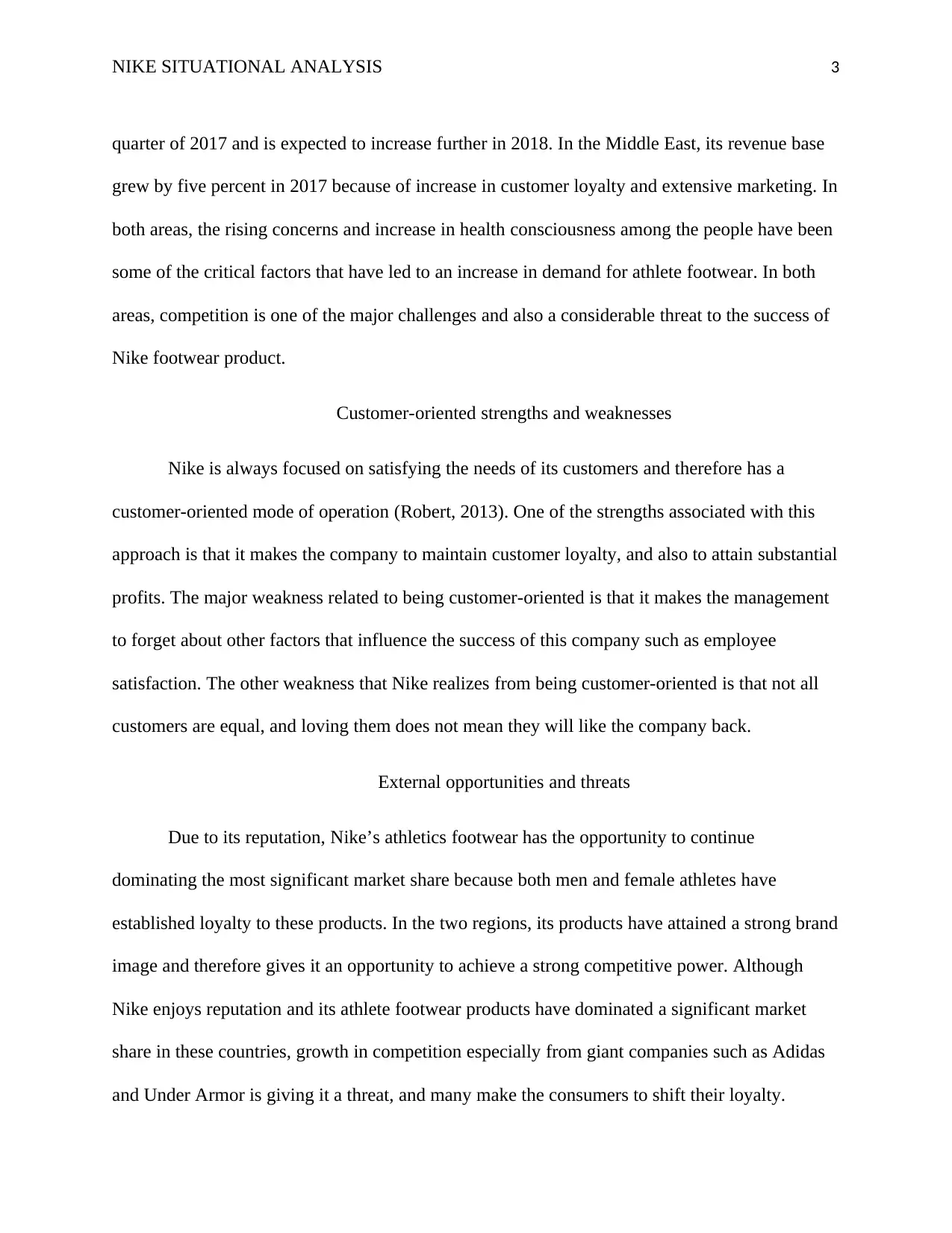
NIKE SITUATIONAL ANALYSIS 3
quarter of 2017 and is expected to increase further in 2018. In the Middle East, its revenue base
grew by five percent in 2017 because of increase in customer loyalty and extensive marketing. In
both areas, the rising concerns and increase in health consciousness among the people have been
some of the critical factors that have led to an increase in demand for athlete footwear. In both
areas, competition is one of the major challenges and also a considerable threat to the success of
Nike footwear product.
Customer-oriented strengths and weaknesses
Nike is always focused on satisfying the needs of its customers and therefore has a
customer-oriented mode of operation (Robert, 2013). One of the strengths associated with this
approach is that it makes the company to maintain customer loyalty, and also to attain substantial
profits. The major weakness related to being customer-oriented is that it makes the management
to forget about other factors that influence the success of this company such as employee
satisfaction. The other weakness that Nike realizes from being customer-oriented is that not all
customers are equal, and loving them does not mean they will like the company back.
External opportunities and threats
Due to its reputation, Nike’s athletics footwear has the opportunity to continue
dominating the most significant market share because both men and female athletes have
established loyalty to these products. In the two regions, its products have attained a strong brand
image and therefore gives it an opportunity to achieve a strong competitive power. Although
Nike enjoys reputation and its athlete footwear products have dominated a significant market
share in these countries, growth in competition especially from giant companies such as Adidas
and Under Armor is giving it a threat, and many make the consumers to shift their loyalty.
quarter of 2017 and is expected to increase further in 2018. In the Middle East, its revenue base
grew by five percent in 2017 because of increase in customer loyalty and extensive marketing. In
both areas, the rising concerns and increase in health consciousness among the people have been
some of the critical factors that have led to an increase in demand for athlete footwear. In both
areas, competition is one of the major challenges and also a considerable threat to the success of
Nike footwear product.
Customer-oriented strengths and weaknesses
Nike is always focused on satisfying the needs of its customers and therefore has a
customer-oriented mode of operation (Robert, 2013). One of the strengths associated with this
approach is that it makes the company to maintain customer loyalty, and also to attain substantial
profits. The major weakness related to being customer-oriented is that it makes the management
to forget about other factors that influence the success of this company such as employee
satisfaction. The other weakness that Nike realizes from being customer-oriented is that not all
customers are equal, and loving them does not mean they will like the company back.
External opportunities and threats
Due to its reputation, Nike’s athletics footwear has the opportunity to continue
dominating the most significant market share because both men and female athletes have
established loyalty to these products. In the two regions, its products have attained a strong brand
image and therefore gives it an opportunity to achieve a strong competitive power. Although
Nike enjoys reputation and its athlete footwear products have dominated a significant market
share in these countries, growth in competition especially from giant companies such as Adidas
and Under Armor is giving it a threat, and many make the consumers to shift their loyalty.
⊘ This is a preview!⊘
Do you want full access?
Subscribe today to unlock all pages.

Trusted by 1+ million students worldwide
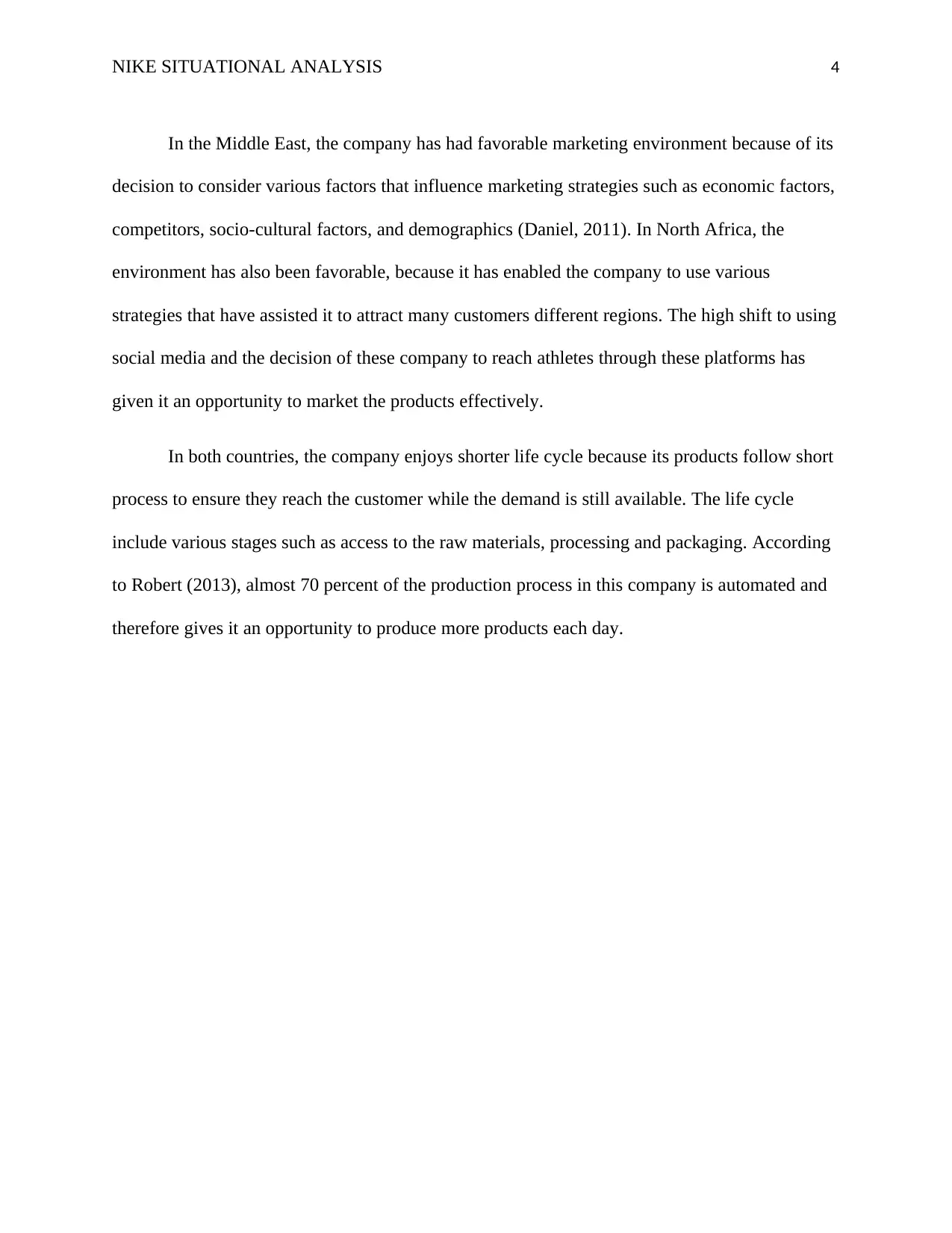
NIKE SITUATIONAL ANALYSIS 4
In the Middle East, the company has had favorable marketing environment because of its
decision to consider various factors that influence marketing strategies such as economic factors,
competitors, socio-cultural factors, and demographics (Daniel, 2011). In North Africa, the
environment has also been favorable, because it has enabled the company to use various
strategies that have assisted it to attract many customers different regions. The high shift to using
social media and the decision of these company to reach athletes through these platforms has
given it an opportunity to market the products effectively.
In both countries, the company enjoys shorter life cycle because its products follow short
process to ensure they reach the customer while the demand is still available. The life cycle
include various stages such as access to the raw materials, processing and packaging. According
to Robert (2013), almost 70 percent of the production process in this company is automated and
therefore gives it an opportunity to produce more products each day.
In the Middle East, the company has had favorable marketing environment because of its
decision to consider various factors that influence marketing strategies such as economic factors,
competitors, socio-cultural factors, and demographics (Daniel, 2011). In North Africa, the
environment has also been favorable, because it has enabled the company to use various
strategies that have assisted it to attract many customers different regions. The high shift to using
social media and the decision of these company to reach athletes through these platforms has
given it an opportunity to market the products effectively.
In both countries, the company enjoys shorter life cycle because its products follow short
process to ensure they reach the customer while the demand is still available. The life cycle
include various stages such as access to the raw materials, processing and packaging. According
to Robert (2013), almost 70 percent of the production process in this company is automated and
therefore gives it an opportunity to produce more products each day.
Paraphrase This Document
Need a fresh take? Get an instant paraphrase of this document with our AI Paraphraser
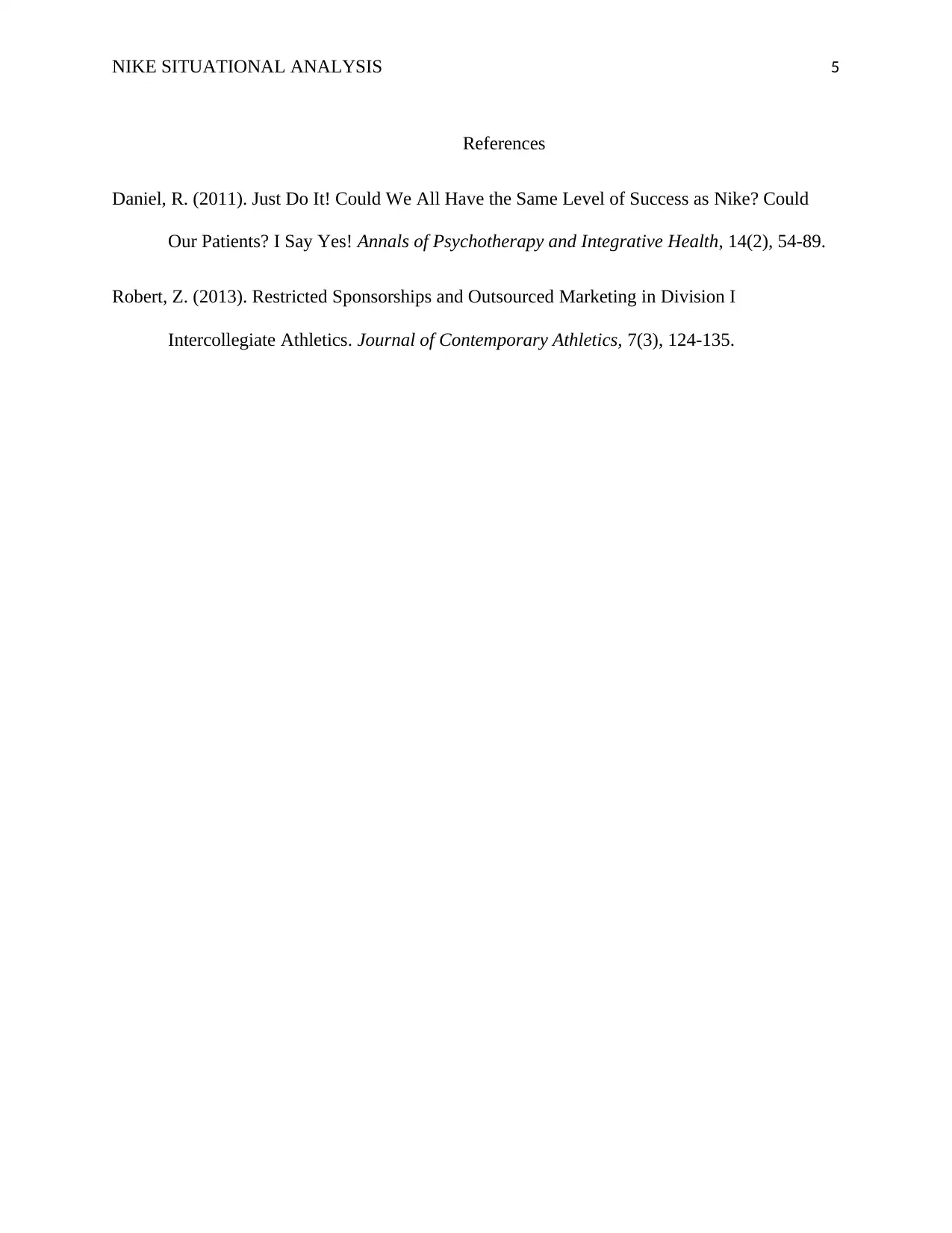
NIKE SITUATIONAL ANALYSIS 5
References
Daniel, R. (2011). Just Do It! Could We All Have the Same Level of Success as Nike? Could
Our Patients? I Say Yes! Annals of Psychotherapy and Integrative Health, 14(2), 54-89.
Robert, Z. (2013). Restricted Sponsorships and Outsourced Marketing in Division I
Intercollegiate Athletics. Journal of Contemporary Athletics, 7(3), 124-135.
References
Daniel, R. (2011). Just Do It! Could We All Have the Same Level of Success as Nike? Could
Our Patients? I Say Yes! Annals of Psychotherapy and Integrative Health, 14(2), 54-89.
Robert, Z. (2013). Restricted Sponsorships and Outsourced Marketing in Division I
Intercollegiate Athletics. Journal of Contemporary Athletics, 7(3), 124-135.
1 out of 5
Related Documents
Your All-in-One AI-Powered Toolkit for Academic Success.
+13062052269
info@desklib.com
Available 24*7 on WhatsApp / Email
![[object Object]](/_next/static/media/star-bottom.7253800d.svg)
Unlock your academic potential
Copyright © 2020–2025 A2Z Services. All Rights Reserved. Developed and managed by ZUCOL.




